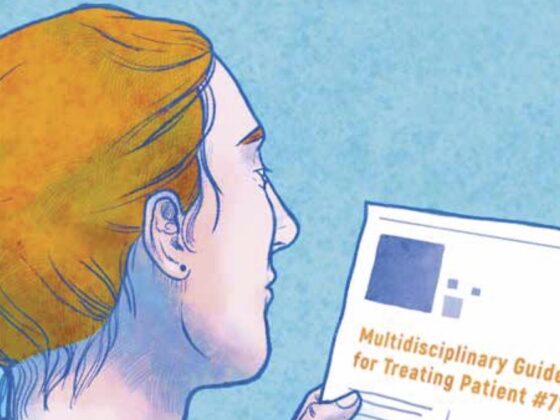This article is from 2020, if you want to read other things on the same topic we recommend:
Professor Isabel Rubio is a surgeon at the top of her profession. She is Director of Breast Surgery at Clinica Universidad de Navarra, Madrid. She is President-elect of the European Society of Breast Cancer Specialists (EUSOMA) and head of public affairs at the European Society of Surgical Oncology (ESSO).
And yet, when male surgeons introduce her, they use her first name when other men are given their surname and title. When she suggests conference sessions on women in surgery, some male colleagues say they don’t see the need. And recently, when a society she was involved in decided to publish a booklet on surgery, it somehow escaped everybody’s notice – apart from hers – that every single surgeon pictured was male.
None of this is as bad as the patronising attitudes Rubio encountered on her way up the surgical ladder, when she was often treated as if she were a child – male colleagues regularly suggested she didn’t have their stamina and told her to take a break while they ploughed on. Nonetheless, such everyday expressions of sexist attitudes do have an impact.
“Our unconscious attitudes, which have arisen from pre-formed associations, can affect what we say and do without our knowledge – and may even contradict our conscious beliefs,” says Rubio. This affects how women progress in surgery. And without enough women at the top, where are the role models for future female surgeons? How will the gender gap in cancer surgery ever be closed?
“There are too few female mentors in surgery and the lack of female role models in surgical leadership contributes to the perpetuation of male stereotypes,” says Rubio.
Women in surgery: the numbers
How much have such attitudes affected the number of women entering, and staying in, surgical specialities? Although getting authoritative statistics on the number of women cancer surgeons across Europe is difficult, the disparity between genders is clear. A forthcoming survey from the European Union of Medical Specialists (UEMS) indicates that in most European countries the proportion of women surgeons is 30% to 40%, while in some countries it is as low as 20%.
Given that the number of women surgical trainees in some European countries now equals the number of men, there’s hope that greater equality is on the way. However, not all of those will choose to pursue a career in surgery, says breast surgeon Malin Sund, a professor of surgery at Umeå University, Sweden, who organised the UEMS survey. She points to findings showing a relatively high dropout rate in many countries. While the number of trained women surgeons not actively working as surgeons is very low in Nordic countries, the UK and Netherlands, it is higher in Germany and reaches 25% in some southern European countries.
“In these countries there are a lot of female surgeons who have trained and then decide not to work as surgeons – which is of course a terrible loss to the system, and a catastrophe for the women themselves,” she says.
The problem is exacerbated by the fact that those women who do stay in the profession appear to face far more obstacles than men in reaching the surgical heights. Equality in positions of seniority is still a long way off.
Changing attitudes
Surgery has traditionally been seen as a profession involving characteristics that are stereotypically ascribed to men: aggression, courage and the ability to make split-second decisions in the face of life-threatening risks.
But in recent decades, increasing numbers of women surgeons have broken into what was once regarded as an exclusive ‘men’s club’, challenging these outdated assumptions. Between 1970 and the mid 1990s the UK saw a tenfold increase in women surgeons.
Thanks in large part to technical progress, the split-second decisions taken in high-risk situations are now seen as far less important than good planning and preparation. Being good at listening and communicating – characteristics more closely associated with women – are now seen as essential clinical skills. At the same time, these stereotypes have themselves been challenged, with the recognition that men can be caring and attentive, while women can be aggressive and courageous – though such behaviour is often still seen as less acceptable in female surgeons than in their male counterparts (Human Organization 1997, 56:47–52).
The biggest driver of changing attitudes was probably down to the pioneering women who began to join the profession in ever increasing numbers, and proved their competence in the operating theatre.
That competence was recently confirmed in a Canadian matched cohort study of postoperative outcomes published in the BMJ, which provided evidence of what everyone already knows: women make just as good surgeons as men. If not better. It found that patients treated by female surgeons had a small but statistically significant decrease in 30-day mortality and had similar surgical outcomes compared with those treated by male surgeons (BMJ 2017, 359:j4366).
“Those women who do stay in the profession appear to face far more obstacles than men in reaching the surgical heights”
So the question remains: why is it that women are still significantly underrepresented in surgery as a whole, and particularly at the higher echelons of the profession?
Is protecting family life the problem?
If surgery still has a gender problem, what lies at the root of it? Could it simply be the old issue of how to combine family demands with the demands of a traditionally high-pressure career? Data from ‘implicit bias’ testing of surgeons, published in JAMA Network Open in 2019, found that male surgeons had a tendency to associate men with career and surgery and women with family and family medicine.
“It’s true that balancing family and surgery sometimes is difficult and I think that this is one reason that women refrain from entering surgical specialties,” says Rubio. “But I don’t think we should be focusing on that. It’s far more complex than that.”
Malin Sund, who became the first ever female professor of surgery in Sweden in 2013, believes the family issue is definitely significant, but is more important in some countries than others. Sweden is one of the countries where the number of women in surgical training is equal to men.
“In the Nordic countries, with our generous social support and good quality day care, it’s fully possible to be a practising surgeon and mother, whereas in many countries that might not be the case,” she says. “There are studies showing that academic surgeons tend to have no children or fewer children than other female physicians, but whether you have to make that sacrifice depends on the country you live in.
“Our survey responses from southern European countries tend to focus on the difficulties of organising family life. So it wasn’t doing the surgery itself that was the problem, but the expected lifestyle of the surgeon – that the work hours are very hard to combine with a functioning family. In the more northern countries, the problems were less about external day care, and more about the division of labour in the home: a lot seems to depend on who you choose to start a family with.”
Is bias and lack of role models the problem?
But there is more going on than lack of financial and social support. Even in Nordic countries there are concerns about equality, not because there aren’t enough women in cancer surgery but because there are not enough women at the top of cancer surgery. This isn’t just an issue about being able to stay in the profession; it’s about being able to be successful in the profession.
Recent research suggests that, although we may like to think that the days of glass ceilings and job discrimination are over, women still face far more obstacles than men in reaching the surgical heights. A UK survey of women surgeons published in the BMJ this year found that 59% had reported or witnessed discrimination. Trauma surgery and orthopaedics were identified as having the most sexist cultures by more than half of respondents. More than one in five said they perceived a “glass ceiling” in surgical training (BMJ Open 2019, 9:e024349).
In the US, a recent survey of plastic surgeons revealed similar findings. Women were more likely than men to have experienced sexism or bias, and were less likely to feel recognised for ideas, authorship, promotions, or pay rises. Women also felt that their sex was a disadvantage in career advancement (Plast Reconstr Surg 2018, 142:252–64).
As Isabel Rubio points out, role models are important here. Her own mentor, Suzanne Klimberg, was an important influence during her US Fellowship – and afterwards. “I saw how she worked and how she had the same difficulties as me, but she still succeeded. Seeing a woman who can achieve anything – give talks at big congresses, be president of societies, be chief of breast surgery – helped me a lot. It helped me realise that I didn’t have to enter into the male thing of demonstrating that you can operate for 12 hours at a stretch, for example. We can do it our own way and be just as good.”
Malin Sund agrees that role models help young female surgeons see a way of navigating the system. Until they become more common and visible, there may be problems making any ambition seem realistic. But she points to another problem continually pulling that kind of aspiration back.
Is it about ‘old-boys’ networks’ and just being different?
The UEMS survey showed that women feel excluded from the male-dominated networks where promotions are unofficially discussed and decided. “This is interesting from a Scandinavian or Swedish perspective, because I don’t think women don’t get up the hierarchy because men aren’t being nice. It’s just that the networks that develop before training and during training become somehow self-promoting of men,” says Sund.
Facing such issues is key if women are to be properly represented in the highest echelons of cancer surgery, according to cancer surgeon Peter Naredi, Professor of Surgery at the University of Gothenburg and Sahlgrenska University Hospital, Sweden.
He points out that, while socioeconomic factors may still explain the gender imbalance in those seeking a career in surgery in many areas of Europe, this is no longer a major factor in countries like Sweden – and yet the gender ratio remains stubbornly weighted towards men. “In Sweden both the man and the woman have to take maternity or paternity leave and you don’t lose too much on your pension if you are home with kids for two years. Yet even if parents share the social responsibilities, it is still hardly changing the ratio of female to male surgeons.” Part of the problem, says Naredi, is lack of opportunity for younger entrants. “We are so many older surgeons taking up the space.”
So in northern and western Europe, it’s partly a matter of waiting for “old dinosaurs like myself” to move on, he says, leaving space for women coming up through the ranks. But Naredi worries that there is still a considerable and subtle barrier preventing this – the unconscious discriminatory force which he recognises he himself, as a male, is part of.
“When I’m looking for a successor as head of my breast surgical unit, or of a research group that I’m running, there’s an official system in place that’s very objective. But in practice, what you tend to do is choose someone who’s very much like you. As the present – male – head, you might think of that male surgeon, 20 years younger than you, who you’ve been working with for 15 years. And then you find arguments why this person has more merits than the female surgeon who has also been working with you for 15 years.”
And so, the male dominance of senior positions continues. “This is the hidden network,” says Naredi. Truly promoting equality in surgery, he says, means choosing people according to formal competence, not whether they ‘fit in’.
“Networks that develop before and during training become somehow self-promoting of men”
“We need the most competent person, the person who can diversify the cancer care, can look at how we serve our society best. There are some countries in Europe, and in the United States, where this has become standard practice, while in other countries we are 10 to 20 years away from that and we continue to choose persons according to the hidden network.”
From the exception to the rule
No matter how much has been achieved in some countries, the current experiences of women surgeons tell their own story.
Isabel Rubio thinks of all those board meetings of surgical societies where she wishes there would be many more women – not simply because she feels outnumbered, but because women and men often approach things differently.
“It’s not a fight, because we need men to work all this out too and to understand that there is a problem with gender bias. To solve it, there’s a need for everyone to realise that some things need to change.”












